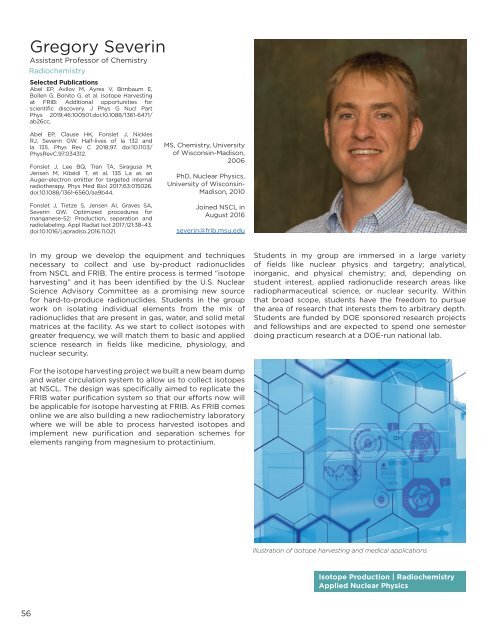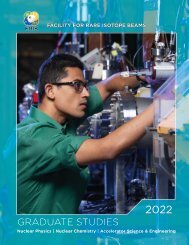2021FRIB/NSCL Graduate Brochure
You also want an ePaper? Increase the reach of your titles
YUMPU automatically turns print PDFs into web optimized ePapers that Google loves.
Gregory Severin<br />
Assistant Professor of Chemistry<br />
Radiochemistry<br />
Selected Publications<br />
Abel EP, Avilov M, Ayres V, Birnbaum E,<br />
Bollen G, Bonito G, et al. Isotope Harvesting<br />
at FRIB: Additional opportunities for<br />
scientific discovery. J Phys G Nucl Part<br />
Phys 2019;46:100501.doi:10.1088/1361-6471/<br />
ab26cc.<br />
Abel EP, Clause HK, Fonslet J, Nickles<br />
RJ, Severin GW. Half-lives of la 132 and<br />
la 135. Phys Rev C 2018;97. doi:10.1103/<br />
PhysRevC.97.034312.<br />
Fonslet J, Lee BQ, Tran TA, Siragusa M,<br />
Jensen M, Kibédi T, et al. 135 La as an<br />
Auger-electron emitter for targeted internal<br />
radiotherapy. Phys Med Biol 2017;63:015026.<br />
doi:10.1088/1361-6560/aa9b44.<br />
Fonslet J, Tietze S, Jensen AI, Graves SA,<br />
Severin GW. Optimized procedures for<br />
manganese-52: Production, separation and<br />
radiolabeling. Appl Radiat Isot 2017;121:38–43.<br />
doi:10.1016/j.apradiso.2016.11.021.<br />
MS, Chemistry, University<br />
of Wisconsin-Madison,<br />
2006<br />
PhD, Nuclear Physics,<br />
University of Wisconsin-<br />
Madison, 2010<br />
Joined <strong>NSCL</strong> in<br />
August 2016<br />
severin@frib.msu.edu<br />
In my group we develop the equipment and techniques<br />
necessary to collect and use by-product radionuclides<br />
from <strong>NSCL</strong> and FRIB. The entire process is termed “isotope<br />
harvesting” and it has been identified by the U.S. Nuclear<br />
Science Advisory Committee as a promising new source<br />
for hard-to-produce radionuclides. Students in the group<br />
work on isolating individual elements from the mix of<br />
radionuclides that are present in gas, water, and solid metal<br />
matrices at the facility. As we start to collect isotopes with<br />
greater frequency, we will match them to basic and applied<br />
science research in fields like medicine, physiology, and<br />
nuclear security.<br />
Students in my group are immersed in a large variety<br />
of fields like nuclear physics and targetry; analytical,<br />
inorganic, and physical chemistry; and, depending on<br />
student interest, applied radionuclide research areas like<br />
radiopharmaceutical science, or nuclear security. Within<br />
that broad scope, students have the freedom to pursue<br />
the area of research that interests them to arbitrary depth.<br />
Students are funded by DOE sponsored research projects<br />
and fellowships and are expected to spend one semester<br />
doing practicum research at a DOE-run national lab.<br />
For the isotope harvesting project we built a new beam dump<br />
and water circulation system to allow us to collect isotopes<br />
at <strong>NSCL</strong>. The design was specifically aimed to replicate the<br />
FRIB water purification system so that our efforts now will<br />
be applicable for isotope harvesting at FRIB. As FRIB comes<br />
online we are also building a new radiochemistry laboratory<br />
where we will be able to process harvested isotopes and<br />
implement new purification and separation schemes for<br />
elements ranging from magnesium to protactinium.<br />
Illustration of isotope harvesting and medical applications<br />
Isotope Production | Radiochemistry<br />
Applied Nuclear Physics<br />
56






